

|
Airborne plaster and all other dusts
are hazardous to
|
The setting (curing) of plaster can be slowed by adding a glue size solution, or by letting it stand for ten minutes before mixing it. Speeding the setting of plaster is seldom needed, but can be done either by mixing with warm water, or by adding a small amount of salt or alum (from grocer).
A release agent for plaster can be a thin clay slip, or several applications of a soft liquid soap, or a thin oil. When doing life casting, petroleum jelly works well as a release agent, and it protects the skin too.
Plaster can be painted when dry, or mixed with pigments while still wet, as in fresco painting. The surface of a plaster sculpture must be sealed to keep dirt from building up in its pores — commonly with wax, shellac or linseed oil.
The term plaster is sometimes used as a synonym for stucco, which is the finest and whitest type of plaster used for modeling and molding. Stucco is made of a mixture of lime (often from marble), white-marble dust, and other ingredients, which might include wax, milk and other organic substances.
Also called plaster is a mixture of sand, dirt and straw, which is the same set of ingredients in adobe.
In order to bond plaster to a flat surface such as a sheet of plywood, obtain a strong wire-screen material, and staple it to the wood, intentionally leaving gaps between some of the wood and the screen. Your choice of wire-screen — poultry-fencing, hardware-cloth, etc. — depends largely on the size of the project. The most inexpensive source for these materials is a retailer of construction supplies.
Follow step-by-step instructions in a lesson introducing the use of plaster — mixing it, adding an aggregate, casting a block and carving it. At the end of these instructions are several other ideas for plaster lessons.
Among the artists especially known for their uses of plaster were Verrocchio (Italian, 1435-1488), Auguste Rodin (French, 1840-1917), and George Segal (American, 1924-2000).
Examples of works in plaster:

Egypt, Eighteenth Dynasty, Ay, Fan Bearer, c. 1360 BCE,
plaster on limestone with
polychrome, Worcester
Art Museum, MA. See Amarna
art.
Jean-Baptiste Carpeaux (French, 1827-1873), Dance, c. 1863, plaster sketch, 54.5 x 34 cm, Musée d'Orsay. This sketch was made in order to produce sculptures for the Paris Opera, a beaux-arts building designed by architect Charles Garnier. See dance.
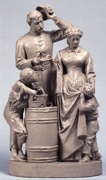
John Rogers (American, 1829-1904), Taking the Oath and Drawing Rations, 1866, cast and painted plaster, Hood Museum of Art, Dartmouth College, NH. See genre.
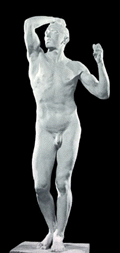
Auguste Rodin (French, 1840-1917), The Age of Bronze, 1877, plaster, height 173 cm, Hermitage Museum,
St. Petersburg, Russia. See nude.
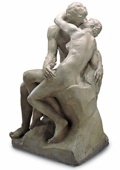
Auguste Rodin, The Kiss (Paolo and Francesca), 1886, painted
plaster, cast from clay original,
Milwaukee Art Museum, WI.
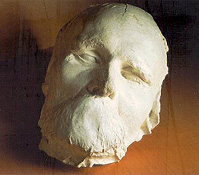
Death mask
of Friedrich Nietsche, German philosopher, 1844-1900, plaster.
Jean [or Hans] Arp (French, born Germany (Alsace), 1886-1966), Human Concretion, 1935, plaster, 19 1/2 x 18 3/4 x 25 1/2 inches (49.5 x 47.6 x 64.7 cm), Museum of Modern Art, NY. Also see biomorphic.
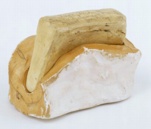
Marcel Duchamp (American, born France, 1887-1968), Wedge of Chastity, New York 1954, plaster in two sections, partly painted, 2 3/4 x 3 7/8 x 2 1/2 inches (6.9 x 10 x 6.1 cm), Museum of Modern Art, NY. See Dada.

Henri Gaudier-Brzeska (English, born France,
1891-1915), Wrestlers, 1914, cast
c. 1965, plaster relief,
71.1 x 92.7 x 7.6 cm, Tate Gallery, London. These figures are stylized
and elongated.

Jacques Lipchitz (born Chaïm Jacob)
(French and American, born Russia, 1891-1973), Head,
1915, patinated plaster,
62 x 27 x 22.5 cm, Georges Pompidou Center, Paris.
![]()
Jacques Lipchitz, A Standing Person, 1916, plaster, 109.2
x 27.4 x 20.2 cm, Georges Pompidou Center, Paris.

Henry Moore (English, 1898-1968), OM, CH,
Reclining Figure, 1951, plaster and string,
105.4 x 227.3 x 89.2 cm, Tate Gallery, London. See figure.
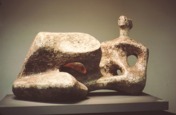
Henry Moore, Working Model for Reclining Figure, UNESCO,
1957, plaster, Art Gallery of Ontario, Toronto.
Alberto Giacometti (Swiss, 1901-1966), The Nose, 1947, plaster on metal, suspended by synthetic string within a metal structure, 81.5 x 66 x 36.7 cm, Centre Georges Pompidou, Paris. See Surrealism.

Dame Barbara Hepworth (English, 1903-1975),
Oval Sculpture (No. 2), 1943, cast
1958, plaster, 29.3 x 40.0 x 25.5 cm, Tate Gallery, London. See
oval.

Sir Eduardo Paolozzi (Scottish, 1924-2005), Michelangelo's `David', 1987, plaster,
wood and string, 31.0 x 24.0
x 21. cm, 7.2 kg, Tate Gallery, London. See Renaissance.
George Segal (American, 1924-2000), The Tightrope Walker, plaster and rope, 65 x 60 x 204 inches (165 x 152 x 518 cm), Carnegie Museum of Art, Pittsburgh, PA.
Claes Oldenburg (American, 1929-), The Black Girdle, 1961, painted plaster, muslin and wire, 46 1/2 x 40 x 4 inches (118.1 x 101.6 x 10.2 cm), Whitney Museum of American Art, NY. See Pop Art.

Niki de Saint Phalle (French-American, 1930-2002),
Untitled, 1964, plaster, paint, plastic,
wood, Walker Art Center, Minneapolis,
MN. De Saint Phalle made a number of works of this type, calling
them "tirs." She used plaster to cover paint-filled
plastic bags, and then shot guns and other things at it, which
caused the paint to come out through the holes produced.

Michael Lucero (American, 1953-), Greek,
1995, found plaster cast, ceramic, and metal,
Carnegie Museum of Art, Pittsburgh, PA. The sculptor
found a plaster cast
of an ancient Greek statue.
To this he added his own ceramic pots in place of the head and
arms broken from the original
sculpture long ago.

Robert Gober (American, 1954-), Untitled, 1984, plaster, wood,
wire lath, aluminum, watercolor, semi-gloss
enamel paint, collection
of the artist, NY.
![]()

Rachel Whiteread (British, 1963-), Untitled (Paperbacks). 1997, plaster
and steel,
room installation, dimensions variable, Museum
of Modern Art, NY. See feminism
and feminist art.
Plaster bandages are strips of cheese-cloth packed with plaster, traditionally used in the making of "casts" around limbs with broken bones. Pariscraft and Plastercraft are less-expensive brands of plaster bandages for such sculptural uses as making masks and molds of body-parts.
Plaster can ruin sponges and clog
drains, so wipe up with paper towels and put wasted plaster in
the trash. Rather than blowing or sweeping the powder, wipe it
up with a damp towel. Scrapers should be at hand for removing
plaster that hardens onto tables and floors.
Also see aggregate, armature, banker, carving, gesso, modeling, parget, plaster trap, slip, and stucco.
https://inform.quest/_art